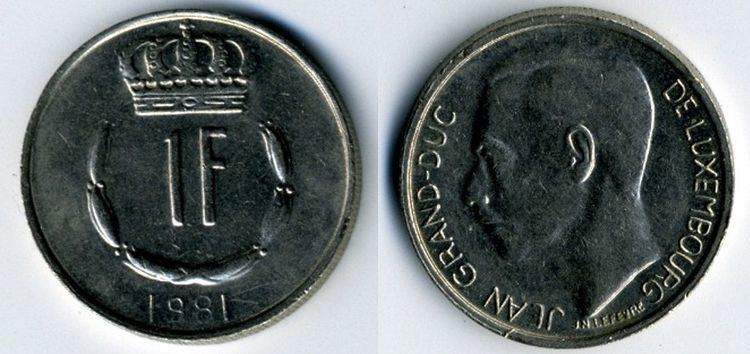Code LUF centime (French)
cent (German) c. | Symbol fr. or F | |
 | ||
⁄100 centime (French)
cent (German) Plural francs (French)
Franken (German)
Frang (Luxembourgish) centime (French)
cent (German) centimes (French)
cent (German) | ||
The Luxembourgish franc (more commonly Luxembourg Franc or LUF, French: franc luxembourgeois, Luxembourgish: Lëtzebuerger Frang, German: Luxemburger Franken) was the currency of Luxembourg between 1854 and 1999 (except during the period 1941-44). The franc remained in circulation until 2002, when it was replaced by the euro. During the period 1999–2002, the franc was officially a subdivision of the euro (1 euro = 40.3399 francs) but the euro did not circulate. Under the principle of "no obligation and no prohibition", financial transactions could be conducted in euros and francs, but physical payments could only be made in francs, as euro notes and coins were not available yet.
Contents
The franc was subdivided into 100 centimes.
History
The conquest of most of western Europe by Revolutionary and Napoleonic France led to the French franc's wide circulation, including in Luxembourg. However, incorporation into the Netherlands in 1815 resulted in the Dutch guilder becoming Luxembourg's currency. Following Belgium's independence from the Netherlands, the Belgian franc was adopted in 1839 and circulated in Luxembourg until 1842 and again from 1848. Between 1842 and 1848, Luxembourg (as part of the German Zollverein) used the Prussian Thaler.
In 1854, Luxembourg began issuing its own franc, at par with the Belgian franc. The Luxembourg franc followed the Belgian franc into the Latin Monetary Union in 1865. In 1926, Belgium withdrew from the Latin Monetary Union. However, the 1921 monetary union of Belgium and Luxembourg survived, forming the basis for the full Belgium-Luxembourg Economic Union in 1932. In 1935, the link between the Luxembourg and Belgian francs was revised, with 1 Luxembourg franc = 1 1⁄4 Belgian francs.
In May 1940, the franc was pegged to the German Reichsmark at a rate of 4 francs = 1 Reichsmark. This was changed to 10 francs = 1 Reichsmark in July 1940. On 26 August 1940, the Reichsmark was declared legal tender in Luxembourg and on 20 January 1941, the Reichsmark was declared the only legal tender and the franc was abolished. The Luxembourg franc was reestablished in 1944, once more tied to the Belgian franc at par.
The Luxembourg franc was fixed at 1 euro = 40.3399 francs on 1 January 1999. Euro coins and banknotes were introduced on 1 January 2002. Old franc coins and notes lost their legal tender status on 28 February 2002.
Use of Belgian franc
Between 1944 and 2002, 1 Luxembourg franc was equal to 1 Belgian franc. Belgian francs were legal tender inside Luxembourg and Luxembourg francs were legal tender in Belgium. Nevertheless, payments in Luxembourg banknotes were commonly refused by shopkeepers in Belgium, either through ignorance or from fear that their other customers would refuse the banknotes (again, either through ignorance or from fear of being denied payment with it later), forcing them to go through the hassle of a trip to their bank to redeem the value of the banknote.
With a few early exceptions, the coins were identical in size, shape, and composition. Although they had distinct designs, the coins circulated in both Luxembourg and Belgium.
Coins
The first coins were issued in 1854, in denominations of 2 1⁄2, 5 and 10 centimes. In 1901, the bronze 5 and 10 centimes pieces were replaced by cupro-nickel coins. In 1915-1916, zinc 5, 10 and 25 centimes coins were issued by the occupying German forces. After the First World War, iron coins were issued in the same denominations before cupronickel was reintroduced in 1924, along with nickel 1 and 2 francs coins. The franc coins bore the inscription "Bon Pour", implying that they were tokens "good for" 1 or 2 francs. Such inscriptions also appeared on contemporary French and Belgian coins.
In 1929, Luxembourg's first silver coins since the late 18th century were issued, 5 and 10 francs. Bronze 5, 10 (smaller than earlier issues) and 25 centimes and nickel 50 centimes were introduced in 1930. The last coins before World War II were cupronickel 25 centimes and 1 franc pieces issued in 1938 and 1939.
The first coins issued after the war were bronze 25 centimes and cupro-nickel 1 franc coins introduced in 1946. These were followed by cupronickel 5 francs in 1949. In 1952, the size of the 1 franc (€0.02) coin was reduced to match that of the Belgian 1 franc coin introduced in 1950. From this time on, all new Luxembourg coins matched the sizes and compositions of their Belgian counterparts, although the 25 centimes (€0.01) was not changed to match the Belgian coin introduced in 1964. In 1971, nickel 10 francs (€0.25) were introduced, followed by bronze 20 francs (€0.50) in 1980 and nickel 50 francs (€1.24) in 1987. The size and composition of the 1 and 5 francs were again altered in 1988 and 1986 respectively to match their Belgian counterparts.
A combination of being a small population and with Belgian coins so abundantly circulating in Luxembourg meant it was seldom necessary for Luxembourg to issue coinage on a year by year basis, especially in later years during design changes when large amounts of coins were minted in Brussels to supply the small country for many years at a time. As a result, some dates appear in mint sets only while many other dates saw no standard issue coins minted at all. Many earlier dates changed frequently with larger denominations often being single year designs.
